CubaDebate 174
Graphic Opinion: Coleros and Resellers

Graphic Opinion: Coleros and Resellers
By José Alberto Rodríguez Ávila
August 4, 2020
Translated and edited by Walter Lippmann for CubaNews.
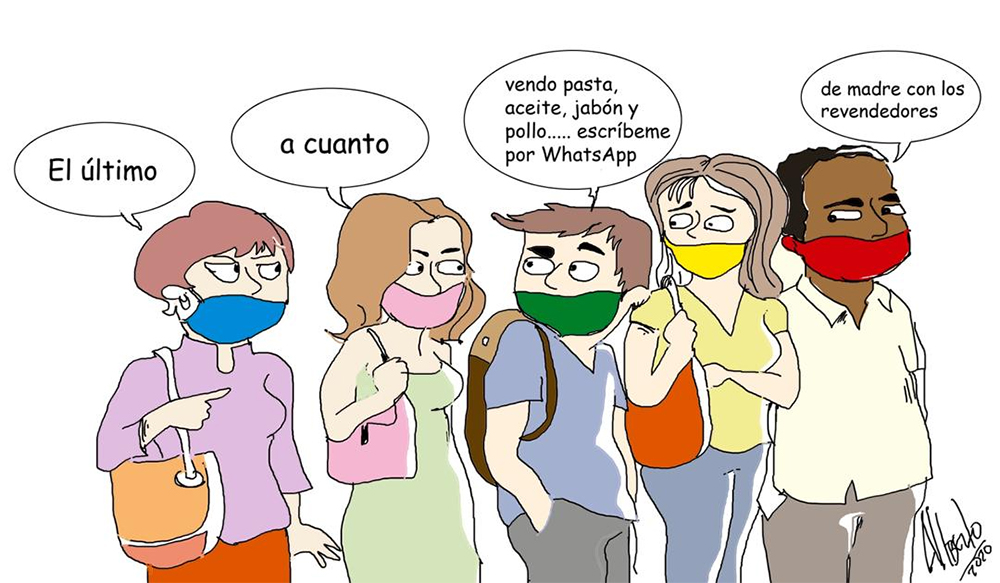
Cartoon: José Alberto Rodríguez/ Cubadebate.
In times of need and shortage, of crisis not only in Cuba but globally, the waiting line as an occupation is the easy alternative for some on the island. Not only to stand on line: then resell at higher prices (with appreciable profit) to others who do work and don’t have the free time that “coleros” do.
No Export Industry Without Design

We Cannot Conceive of an Export Industry Without Design
 By Liudmila Peña Herrera
By Liudmila Peña Herrera
Cuban journalist. Graduated in Journalism from the Universidad de Oriente, in Santiago de Cuba. She works for the weekly Ahora, in Holguín province.
and
 Ivette Leyva García
Ivette Leyva García
Journalist and communicator. Editor of La Tiza, Revista Cubana de Diseño, and contributor to Cubadebate.
July 29, 2020
Translated and edited by Walter Lippmann for CubaNews.
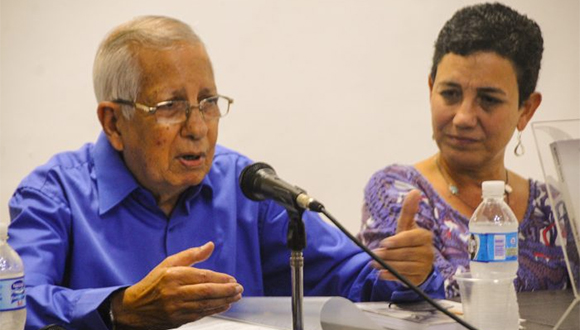
Leonel Amador, during the presentation of one of his books. With him Gisela Herrero, head of the National Design Office. Photo: ONDi.cu
With all the experience and prestige gained by a broad and multifaceted work in the field of light industry over more than six decades of work, chemical engineer Leonel Amador Perez, today an advisor to the Minister of Industries, is an authoritative and proactive voice in the attempt to insert Cuban design in the quality standards of national productions.
A perfumer by profession, Leonel Amador became involved from a very young age – at just 16 – in the fascinating world of fragrances. He himself defines the year 1958 as a determining moment in the destiny that would follow after entering the Rancho Boyeros Technical-Industrial School.
“At that time, the advertising of the big soap companies on the radio and television was very appealing to me. That’s why I chose the specialty of Soap and Perfumery”, remembers who began his professional history in the aerosol filler, in Havana, where they produced the sprays for various cosmetics, perfumes, shaving foams of different brands and many hair products.
His experience in this sector would be enriched in the Burjois Perfumery, producer of Chanel No. 5; then, in the recently created Empresa Consolidada de Jabonería y Perfumería, and later in the Laboratory of Development and Production of bouquets, currently Suchel Fragancia, of which he was one of the founders and its first director, at the age of 23. If such merits still seem insufficient, he is endorsed by having been director of design at the Ministry of Light Industry and winner of the National Honorary Design and Design Management Award, both granted by ONDi.
So many distinctions do not spoil his humility. In the way he conducts himself with his colleagues, there is not the slightest hint of the egocentrism that usually originates such entertainments; on the contrary, in his slow speech and in the frank and clear dialogue, like the essence of one of his perfumes – Alicia, inspired by Prima Ballerina Assoluta -, one can guess the peasant roots of which he assures he is proud.
His tenacity in work and the energy he gives to that passion, make him “jump” to the laboratory from time to time, to compose some fragrance (the last ones were S Hojas de Tabaco Verde, Súcheli Flores Blancas and Insaciable). For him, talking about the challenges and the need to incorporate design solutions into the daily life of a country that is destined to promote productive chains is an obligation, but also a pleasure.
What policies have been developed within the Ministry of Industries to contribute to the productive linkages that, according to the economic authorities, the country needs so much?
-This is an expeditious way for economic actors involved in a production chain to obtain benefits. Logically, the development of one activity drives that of the others and, strategically, it is beneficial and very effective. This policy, within the Ministry of Industries, is not new, since it was born with the Revolution itself and the ideas implemented by Che, who conceived the Cuban industrial development through the productive chains. That is, if we were going to produce coffee, then we would develop the production of the sack and, for that, we would have to produce the fiber, for which purpose the agricultural crops of the kenaf were planted. Today, the policy and programs of industrial development until 2030 take into account these productive chains.
How do you assess the degree of insertion of Cuban design in those chains?
-The insertion of design in the productive chains is vital, although in some processes it is not given the importance it deserves, even when, strategically, it is essential.
“Today, the quality systems that are implemented throughout the industrial plant are based on the evaluation and validation of the design, not only to have a well-assembled quality management system, but also to avoid defective products that do not meet the needs for which they were created. For this reason, design, both industrial and visual communication, plays a very important role in the development of production and in the levels of satisfaction that products and services must achieve.
“We still need to promote it more, because it is not at the center of the company’s management development, even though there are some who have understood the importance of design management, to the point that today they are successful entities in their product development policies.
“It may be that those working in the industry are not always aware of the importance of design, but neither does ONDi and designers have to wait until they are. I believe they should play a more active role in demonstrating the opportunities offered by design as a tool for achieving higher rates of product competitiveness. We cannot conceive of an export industry if it does not have good design. And this is within the policies that the ministry is developing.
“At the moment, we are working on various aspects of the issue. For example, along with the industrial development policy, there is the packaging policy and the design policy; all this so that there is a guiding document in the country that can show us the way to achieve greater efficiency and competitiveness in the product range through design”.
How could designers play a more proactive role in raising awareness of the importance of design?
-There is no one who knows more about the importance of design than the designer himself. We need to get rid of the complaint a little. We need to talk, convince and show more what can be achieved. We must not allow valuable projects to be drawn up and then archived. We have to fight to get these good projects into production.
“Design work must be seen from the industrial management itself, but that is achieved by educating and demonstrating. We developed an experience 25 years ago, at the end of the nineties, with a diploma in management of this activity, at the Instituto Superior de Diseño (ISDi). Thanks to this action of improvement, a group of industry leaders, including me, who was then a vice-minister, prepared ourselves in the most important aspects related to design. Because of those relationships I had with ONDi, I also participated in international events, always presenting papers on the color-smell relationship in the design of packaging for the cosmetics industry and on experiences in design management.
“We also promoted, in coordination with ONDi and ISDi, the experimental reorientation of higher level graduates. It was not a question of improvising designers, but of enriching with these tools professionals who, with a knowledge base such as industrial engineers, chemists, textiles…, could influence, from the industry, design management.
“I owe a lot to the designers I met during the 23 years that I attended to the activity at the ministry level. José “Pepe” Cuendias was a brother…
(Our interviewee briefly interrupts the dialogue. He is moved by the memory of the former director of ONDi and rector of ISDi for so many years. Before our eyes, he is no longer, for a few minutes, the advisor; now we see him in the skin of the friend. He breathes, and continues).
“My relationship with him, in the framework of work, was very close. We planned the training activities together with the staff of the institute. I was also nourished by boys I had known since they were students: Pedrito (Pedro García-Espinosa), Sergito (Sergio Peña Martínez), Giselita (Gisela Herrero García), Carmita (Carmen Gómez Pozo)… There were very talented designers in the industry itself, from whom I learned, like Rafael de León -National Design Award in 2005-, a costume designer for Tropicana and for Vanessa’s trunks, who is very well known internationally”.
How do you assess, from your work experiences, the industry-design relationships over the years?
-In the seventies of the last century, there was a Design Department in the Ministry of Light Industry, whose creation I defended a lot because there was a similar one in the Ministry of Industries of Che. In 1980 the ONDi was created, and the relations between both institutions led to the emergence of design centres in the 1990s, by branches: clothing, footwear, furniture. It was then that, as Vice-Minister, I started to attend to the activity.
“The fact that later the presence of design in industry has been blurred is due to an essentially economic factor. For there to be design there has to be production, and today access to the market for national products is limited by financial problems. We must therefore ensure that part of the solution to this situation is design as a tool. At present, the linkage of the tourism sector and the furniture industry is a positive example. It is satisfying to see the furniture in hotels such as Paseo del Prado, for example; anyone would think that it is not Cuban, and yes, it is manufactured in an industry that is part of that productive chain that we are called upon to promote.
“When you think about how this chain is carried out, you have to take into account that furniture means wood, varnishes, nails, screws, upholstery materials, the clothes of the factory workers, their shoes… Let’s analyze how many things are derived and we will see that it is a big chain in which design plays a fundamental role”.

At present, the linkage of the tourism sector and the furniture industry is a positive example. Image: ONDi.cu.
In his speech to the National Assembly of People’s Power in December 2019, President Miguel Díaz-Canel posed the challenge of “conquering the greatest possible prosperity”, even in the midst of the economic war we are facing. How can we accompany this objective from industry, from design, in the medium term?
-For me, Cuban industry is committed to be better, to overcome every day, and it will achieve it by working more efficiently and effectively, developing the products that Cubans want and deserve. In that challenge, design is an essential tool, because with it we can adapt the product to the needs of the population in an optimal way.
“Likewise, ONDi must use all its experience and knowledge to help raise awareness among industry specialists and to definitively materialize the use of design in each work, product or service that will be made available to our public.
“It must never be forgotten that if you do not have a design that is competitive with the international average, it will be very difficult to export. To achieve this, you must have stable quality and be very punctual with design solutions”.
In July 2020, ONDi celebrated its 40th anniversary. What idea or message would you like to convey to your collective, who are committed to making Cuba a country of good design?
-We must continue to maintain our professional commitment as we have done up to now, and even more. I know the spirit of work of the office, the battle of its designers who radiate a willingness to help in everything they have been asked to do. I just want to invite you to continue to be an example of that passion for design. That needs to be multiplied.
Of Parents…

Of Parents…
 By Dixie Edith
By Dixie Edith
Cuban journalist and professor at the Communications Department of the University of Havana. On Twitter @Dixiedith
June 19, 2020
Translated and edited by Walter Lippmann for CubaNews.

Many parents, more and more, are wondering if it is worth keeping their hands tied in the face of the hard work that tradition has destined them to do. Photo: Amanda Terrero.
Fernando wanted to be a father. When he looked at his four-year-old son, he wanted to be a father. I met him a little less than five years ago on a bumpy inter-provincial flight. From the beginning of an endless wait, I was surprised to see the way the young man related to his little boy. He explained the causes of the plane’s delay as if they were bedtime stories, played with wooden blocks, fed him with infinite patience and then improvised a bed for him between several seats. The child, restless to the point of exhaustion, rested his head on his lap at every turn.
When the blessed flying device finally appeared, Fernando and I ended up sitting together and, for the sake of the Caribbean DNA that flows in us, I served as a handkerchief for tears during the short journey to the East. In just a few months, the young man, born in Bayamo, had been divorced, a promising job offer was placed under his nose in Havana, and he was immersed in a tough legal battle over the shared custody of his son. Without eating or drinking, the little boy had become a cursed chess piece between a mother, still upset by a separation she neither sought nor wanted, and a father claiming his rights.
A family court ruled months later in favor of Fernando. The last time we spoke, however, he told me that, at the gates of every holiday period, the pitched battle over whether he could bring the child to the capital began again. This is because the mother lives looking for pretexts to prevent it. Especially now that he has a new family and a baby a few months-old baby. But “Carlitos loves his little sister,” he said proudly.
When the world was worried about the arrival of the new millennium and the technological blackout that it would produce, the academic world spoke of a phenomenon that specialists called “crisis of masculinity”. This was a reflection on the break-up of patriarchal traditions, where the most traditional roles were being blurred and mixed up hand-in-hand, above all, with a re-evaluation of fatherhood.
The feminist movements had already explained to exhaustion that all this distribution of social functions that are assumed to be natural are not so natural. They are culturally-constructed and can, therefore, be changed. On the other hand, men like Fernando came to the conclusion, by different means, that one is not “less of a man” for not complying with a good part of the requirements that tradition assigns to them.
The North American journalist Susan Faludi illustrated the mentioned crisis with symptoms common to many of her fellow countrymen: increase of stress and signs of anguish, demonstrated in depression, suicides and violent behaviors; the strong demand for plastic surgeries by men, more and more accepted; steroid abuse and their own Viagra sales.
In developed Europe, the debates went through quite similar paths. It’s globalization, isn’t it? And in Latin America, although the patriarchy was still championing its respect, the much-vaunted crisis was also a topic of discussion. For Chilean sociologist Elvira Chadwick, the main change came from the fact that “men went from being the only providers to having to share that role with women who go out to work just like them. Women, who are increasingly incorporated into the world of work, are now not only work colleagues, but also often bosses. This, together with the usual competitiveness of modern societies, caused, according to Chadwick, a “man on the verge of a nervous breakdown”.
Twenty years later, things are more or less on the same wavelength, with the aggravating factor that a conservative and very fundamentalist wave is threatening to swallow us whole. The internet is full of voices calling for a return to the “original family”. Make no mistake about it, this axiom is not just about opposing equal marriage and the right to adopt babies by same-sex couples. It is also about putting women back in the kitchen and men back in the public eye. It is about rescuing those outdated arguments that there is “only one mother” and any [cone can be a] father’. Arguments that would not help Fernando to win his battles.
Specialists in family themes agree that we are experiencing moments of change where models of progress coexist with others of regression. Although daily life shows that, inside, in many houses one still lives “the old-fashioned way” when it comes to roles, points of light illuminate the paths of parenthood. Relationships within the homes are changing and although the transformation is slow, today we can see everything: families where change is a fact and others that have not yet tried to break with the old patriarchal tradition. In the midst of these hurricane winds, many parents, more and more, are asking themselves if it is worthwhile to keep their hands tied in front of the hard work that tradition has destined them to do.
I have had the privilege of meeting many of them. From the cradle. I was educated by two “luxury” people, one biological and the other who arrived later, by the work and grace of reconstituted families. After almost half a century, coexistence is mixed with genes and I no longer recognize differences. As if this were not enough, I share my daily life with men, who are far away from the generation, and who practice paternity very seriously and with pride: Ariel, of course; but also Mario Jorge, Toni, Paquito, Juan Antonio, Santiago and Juan Carlos; or, much younger, Armando, David, Regis, Abdiel, Miguel Ernesto, Jorge… the list is not so short.
But changing the way of thinking of a whole society requires coherence and clear messages. How many obstacles still exist in maternity hospitals for new parents to participate in the birth on an equal footing with their partners? How many custody disputes after a divorce end up almost automatically favoring the mother, without thinking that the potential Ferdinand, counterparts to the conflict, are not always the bad guys in the movie? How many bosses unhesitatingly accept a man’s request for permission to care for his little newborn?
Sergio, one of those fabulous parents I’ve come to know, complained a lot about the bad times that accompanied the arrival of his first child. Not only was he prevented from being present at the birth. He spent most of the time postponing that women’s issue and the times he tried to inquire, get involved, participate… doctors and nurses treated him with that kind of indifferent condescension: Don’t be nervous, everything will be fine, but you have to be patient.
That longed-for transit of customs, of traditions, must go smoothly. It cannot happen that the same society that pressures men, on the one hand, to assume paternity in a conscious way, underestimates them on the other hand. While spaces such as the National Center for Sex Education (CENESEX) are talking about responsible fatherhood these days and UNICEF calls for “being fathers from the beginning”, others, social and institutional, are sending contradictory signals, even in the best of cases. And it can happen, simply, that a man jumps over his prejudices, assumes half of the daily burdens at home, and one morning, when he arrives at the children’s cirdulo as every day, she throws a bucket of cold water on him: “Dad, tell mom that tomorrow there is a parents’ meeting”. A parents’ meeting?
ELN: “We are on a peace mission”

Pablo Beltrán, ELN negotiator:
“We are in Havana on a peace mission, totally detached from military operations”
 Dianet Doimeadios Guerrero
Dianet Doimeadios Guerrero
Deputy director of Cubadebate. Holguín, 1988. Graduated from the Universidad de Oriente. Reporter for the newspaper “Ahora!” from 2010 to 2012. Contact: dianet@cubadebate.cu Twitter: @ddoimeG
Cuban journalist. Works in the Cuban Television Information System. He is a frequent panelist on the informative program Mesa Redonda de la Televisión Cubana. Permanent collaborator of Cubadebate.
July 13, 2020
Translated and edited by Walter Lippmann for CubaNews.
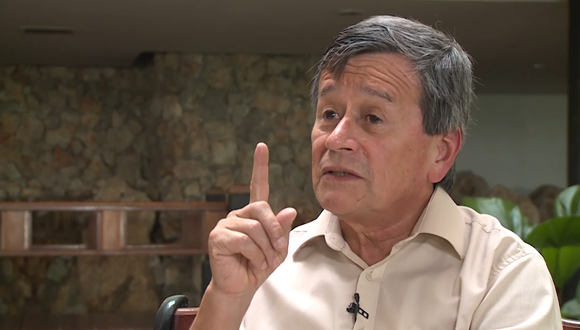
The commander of the National Liberation Army, Pablo Beltrán.
In Havana, one year and five months after the attack, Commander Pablo Beltrán states categorically in an exclusive interview with Cubadebate that none of the 10 members of the peace delegation of the National Liberation Army (ELN) were involved in the attack on the General Santander Police Cadet School in Bogotá. Not even himself, as a member of the Central Command (COCE).
After the event, which on January 17, 2019 took the lives of 22 students and the attacker himself, Colombian President Iván Duque Márquez decided to break off the peace talks with the ELN guerrillas and reactivate the arrest warrants against the members of the delegation, in Cuba since May 2018.
Today, the position of the Cuban authorities to respect the protocol of breaking the talks between the Colombian government and the ELN, and the decision not to extradite the guerrillas, are being used to question and manipulate the role of the Island as a guarantor of the peace process. Beltrán insists that the peace negotiators are “totally detached from any question of military operations” on Colombian soil.
-Commander Beltrán, what is your opinion on the Colombian Government’s argument for requesting the extradition of some of the members of the delegation following the attack on the cadet school?
-First, since we arrived in Cuba in May 2018, a commitment was made. It was the Santos Government and the National Liberation Army who asked Cuba to host the talks, as a guarantor country. That is why we came here, at the request of the parties. And Cuba, as a guarantor country, responded to that request. Secondly, when the new government was installed, it did not say: “Hey, come on,” but rather it said: “Stay there and let’s have a discreet meeting, let’s see what the other government left behind and we’ll restart”.
“When there was an attack by one of our guerrillas on a militarized police school in Bogotá in January 2019, it occurred to them to say that the delegation, even though it was here in Havana, was responsible. Something pulled out of their hat, isn’t it? Because we are here and, besides, I am a member of the national leadership of the ELN, but that does not mean that I am aware of or am commanding military operations in Colombia. My specific task is this whole process of dialogue.
“I am away from that, but even so, they insist on saying that the delegation had something to do with the attack, and based on that they ask Cuba for extradition, but the extradition is requested through Interpol. It turns out that Interpol’s statute, in chapter III, says that this type of matter does not proceed when there are conflicts between parties, that is, an internal Colombian conflict”.
-So you rule out any link between the peace delegation and the attack on the General Santander Police Cadet School in Bogotá?
-Yes, because we are here in Havana on a peace mission and totally detached from any issue of military operations; neither by communications nor by command, we have nothing to do with that, because that was the commitment we made with the two governments, the Colombian and the Cuban.
“I tell you, moreover, a specificity of how the ELN is structured. We have a national leadership, with about 20 members; a kind of executive, the central command, which there are five of us. We also have a body in charge of planning and conducting the operations, the General Staff. It is led by the military head of the central command, who is not me. So, the lines of operation that are drawn, the details of the operations, the times of the operations, the targets chosen, that’s strictly the management of the General Staff.
-Are there any members of the General Staff in Havana?
-No, there isn’t. The military leader of the ELN is Antonio Garcia. He was here in negotiations, but as in 2005, 15 years ago.
-Do you consider that the rupture and the crisis it has generated have been used to attack the guarantor countries?
-Very much so.
-There is information that relates this issue to the inclusion of Cuba in the list that the US Government is drawing up of countries that supposedly do not do enough in the fight against terrorism. How do you assess the position of the guarantors? Have they complied with the law, with the protocols written in black and white?
-It is a law of international peace negotiations to protect negotiating delegations, and the mechanism used is to sign a safe return protocol. We signed the agenda for the negotiations on 30 March 2016 in Caracas, and on 5 April, five days later, we signed the operating protocols, including the protocol of rupture, which is signed by the Colombian government, the ELN and five guarantor countries. That gives it the status of an international agreement; it was not just that Santos signed it, no, it is an international agreement and as such it has to be complied with.
“So, what the guarantor countries have said to the Colombian Government is that they are not going to dishonor their functions as guarantors. The focus of Norway’s foreign policy is the promotion of peace, and they accompany many processes around the world. The day that Norway says that it invalidates its responsibilities as a guarantor country is the day that it ends up accompanying peace processes.
“No one in the international community is going to do that, because in a world that has to be multilateral, every time there are conflicts there will have to be negotiations and negotiating teams; otherwise, there will be no more multilateralism”.
-And what do the protocols say about breaking up? What guarantees of life do they give to the parties who sit down at a table to dialogue?
-The Government of Colombia is committed to returning us safely to our camps, from where we left to conduct these negotiations; the guarantor countries, as has been the custom throughout these negotiations, are committed to accompanying us from the time we leave the negotiating site until we reach a safe place. That is what the safe return protocol strictly says.
“The guarantor countries have told the Government of Bogotá that their position to demand compliance with the protocol of rupture is invariable; neither today, nor tomorrow, nor next year, nor the following century will they change it. And the whole of the international community is increasingly accompanying the guarantor countries in this defense of the protocols”.
-Did Duque give any indication of an intention to break the dialogue table before the attack?
-The first thing they did the day after they positioned themselves was to put Ceballos (Miguel Ceballos Arevalo, High Commissioner for Peace) on the phone with me. I was here in Havana. He told me, “Well, we are going to hold a discreet meeting for several days, a part of the ELN delegation that is in Havana. That’s how contact began. Duque spoke of reviewing and making a connection with what Santos had left; but they never did it, they did not even deign to receive the agreements. And when they asked Duque what he was going to do with the agreements Santos had signed, he said ‘those are not valid because I did not sign them’.
“Then there were jokes in Colombia like ‘well, then he shouldn’t pay the foreign debt, because he didn’t sign it… since it’s eating up half of our GDP.
-Santos did not sign, the Colombian State did.
-Sure. The Constitutional Court said that at least three governments in a row are obliged to implement the Peace Accords. That’s what the Court says, but the government doesn’t care.
-Although the agreement is legally protected…
-If you look, Congress is closed, the president has already issued 160 executive orders governing, doing and undoing everything they could not do when Congress was open. The prosecutor is an employee of the president… That’s a dictatorship.
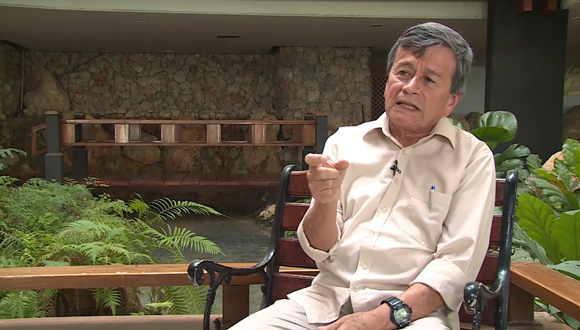
The guarantor countries have told the Bogotá government that their position in demanding compliance with the break-up protocol is unchanged, Beltrán says.
-In recent months, the ELN has taken some decisions that have been well-received by public opinion in the midst of the crisis in the peace process. For example, ceasefires and the release of detainees. How should these gestures be interpreted? Are they sending a message to the Government of Iván Duque?
-It has several interpretations. One is that the government is being told that the ELN is in a position to make peace, to pursue a political solution, and we invite it to join in. The other is that, in the Colombian conflict, the main victims are non-combatants, the population in general; the most impoverished and excluded areas are those that suffer the most. Therefore, every gesture that we can make has a fundamentally humanitarian message, it is not only as if we were ingratiating ourselves with the Government; it is also an invitation and, in essence, a humanitarian gesture.
-In the last few days, you have said that there will be no more unilateral ceasefires, only bilateral ones.
-Yes.
-Why?
-When the United Nations Secretary-General, António Guterres, called a ceasefire in March to better confront the pandemic, we accepted the proposal and made a unilateral ceasefire, but unfortunately, the military and paramilitary forces of the government took military advantage of that.
“For example, in many regions where we are, the persecution and assassination of social and community leaders has increased. So, today we say that we have the disposition for a new cease-fire in compliance with the United Nations resolution, but we also tell the government to participate, to join in a bilateral cease-fire that, in the end, is what will allow us to better confront the pandemic.
“I do not have a precise figure, but several hundred members of the Colombian Armed Forces are infected. There are countries that have had to confine their military forces due to the high level of contagion. It is not only a question raised by the UN; there is also a real threat of contagion within the armed forces”.
-But the government has already responded…
-The government’s a little tangled. President Duque went out on a tweet to say that he was setting conditions for the ELN to enter into a bilateral ceasefire, and it turns out that he is knocking on the wrong door, because it is the Security Council that is demanding the 90-day ceasefire, not the ELN. So let him answer the Security Council.
“We accept the call, the demand of the Council, and we believe that the best way is through bi-lateralism: that the government does it and the ELN does it. The response given by President Duque to the ELN is to knock on the wrong door and [that] does not exempt it from responding to the Security Council”.
-What do you think about the conditions that Duque has set for the bilateral ceasefire for 90 days? For example, he demands that the detainees be released.
This is the dark side of the matter, because, before he was in government, Duque was part of a very violent extreme right-wing coalition in Colombia, led by former President Uribe, which moves with a slogan: ‘Shatter the peace’. So, everything that the previous Santos government did, they came to hinder it.
“They come into the government and what are they going to do, well, shatter the peace. And they have done it. One example: as a result of the Peace Agreement of 2016, voluntary substitution plans were agreed upon with thousands of peasant communities that grow crops for illicit use, in order to eliminate those crops and start new ones, to promote the peasant economy. The first thing Duque did was to obey the dictates of Trump, who says ‘that’s not valid, and does me the favor and sprays me with glyphosate’. From that point on, social protest exploded throughout the region, with people demanding the fulfillment of the agreements and the army and police forcibly settling down, mistreating peasants and murdering several of them. Why? Because they were following orders from Trump.
“In Colombia, there is a very strong discussion, because it is a loss of sovereignty and the people who analyze Colombian foreign policy say that never had there been such a dark time, of so much unconditionality of the Government of Bogota before Washington. So, the problem is not only that Colombians want the peace process, it is that we have to fight with the United States to let it flow”.
-That could explain such a radical change in the Colombian State in the face of the dialogues with the ELN, the transformation of Santos to Duque. What else or who is moving Duque?
-Last Monday, former President Uribe had the idea of saying in a forum, I believe in Madrid, that the progressive opposition forces that want to reach the government in 2022 are a kind of reissue of Castro-chavism. Former President Uribe said this on Monday and Duque repeated it on Wednesday. I remember what Freud says, that when two people say the same thing, there is only one who thinks.
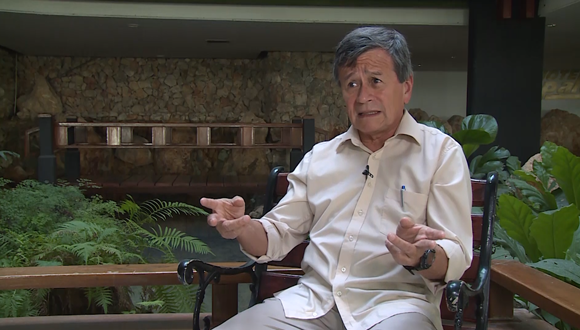
Duque was part of a very violent far-right coalition in Colombia, led by former President Uribe, he says.
-But during the first five months of the Duque government you were in dialogue. Could you cite some examples of the rapprochement between the guerrillas and the Executive?
-The coalition in the government is very diverse, a mix that ranges from fundamentalist evangelicals to the violent extreme right, including right-wing academics. There are some who agree with the dialogue and others who do not. We sent a peace officer last December to talk to former President Uribe and several contacts were made. At the end of December, he was arrested.
“So, if someone goes with goodwill to make discreet contacts and the same person who attends to him penalizes him, how do you build trust? I saw in the press on Thursday that in the prison where they are holding him, two dozen people have already been infected by COVID-19. There he is paying for this effort for peace.
-Can it also be said that Ceballos Arevalo, the Colombian government’s high commissioner for peace, changed his speech?
-That is a very serious problem in Colombia, because in the bureaucratic distribution of the government coalition, the position of peace commissioner is assigned to the Conservative Party. So, the faction of the Conservative Party that is with Uribe does so with Vice President Marta Lucía Ramírez, who is the head of Ceballos. But, at the same time, there is a think tank from an extreme right-wing university, Sergio Arboleda, from which Duque and Ceballos came, and the prosecutor who sets the lines on what to do in government. Surprise! Among the owners of that university is the Díaz-Balart family. What a small world, right?
-Is there any support or opposition from Colombian society and the political elite for breaking the dialogue between the government and the ELN?
-Colombia today is experiencing a kind of political storm that is coming. This week there have been several pronouncements in favor of resumption of the peace agreements. On Monday, Monsignor Monsalve, Archbishop of Cali, said: ‘They are carrying out a genocide with the agreements and with FARC’. More than 220 ex-combatants have been killed, more than 50 of their relatives have been killed… They are displaced, persecuted. They are displaced, persecuted. The intention to destroy peace was not left only for the papers, the people are suffering from it.
“Also on Monday, 94 U.S. congressmen told Duque (that is, Secretary Pompeo): ‘You have to guarantee compliance with the peace agreements; second, you have to stop the assassination of social leaders in Colombia and former combatants; third, you have to dismantle your paramilitary forces. On Wednesday, an important group of Colombian congressmen told Duque: ‘President, agree to a bilateral ceasefire with the ELN’. Very serious things are happening against peace. The political storm is no longer in the Colombian sphere and is now in a wider sphere”.
-Have you ever been sent from Colombia to stand up at the dialogue table?
-No, because the first instruction given to us by the national leadership is that we are never going to get up from the dialogue table, no matter how big the obstacles, the attacks. What we have said to the government is “name your delegate”. Ah, if you don’t want your delegates, then we will return to the camps.
-Is there any chance that the dialogue between the Colombian government and the ELN will be resumed?
-Yes. -Next month, Duque will barely be two years in office. He will have another two years left, and we have indications that all governments want to go down in history because they did something for peace, because that pays off politically, even if they do not do anything very concrete. This government must not be the exception and, furthermore, pressure from Colombian society and the international community to respect the peace agreements and resume dialogue continues to grow.
-In the medium and long term, do you see a definitive solution to the continuation of the revolutionary option through armed means?
-When there is a regime that no longer only kills leftist activists or leaders in Bogotá, but also indigenous leaders, peasants, it is committing genocide, systematic extermination. When you face that kind of extermination, the only thing that saves you is to defend yourself, to resist. In our case, we say that we have a firm commitment to agree an end to the armed conflict, but that this also implies transformations, because if you remove the consequences but leave the causes intact, the conflict remains.
“The most serious cause is the violence of politics. The majority in Colombia believe that Uribe is happy to bring violence into politics and he will be the last one to take the violence out of politics. We have the sincere willingness, but we doubt that the system has it. We say ‘count on the ELN for the political solution’, but the ELN will defend itself and resist.
-What conditions would they set to disarm?
-Colombia is a very complex country. I am going to give you a figure from about ten years ago, when they made a survey of the number of weapons they had given to civilians who were sympathetic to the extreme right. Two million. The Colombian Army and the Police total 500 000.
“When one talks about taking violence out of politics, it is not only that the army and the police stop considering everyone who opposes them as an internal enemy, but that everyone’s weapons are put on the table, because if it is only going to be the ELN’s, that is a story for minors.
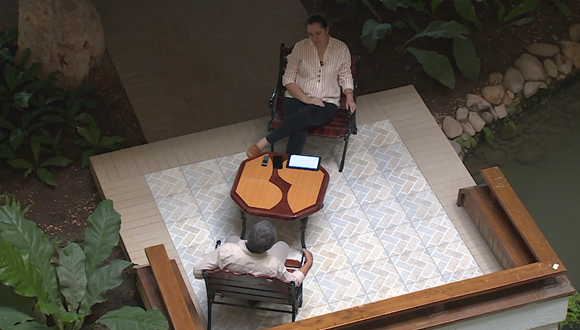
La mayoría en Colombia considera que Uribe está contento metiéndole violencia a la política.
-What lessons does Pablo Beltrán draw from the Peace Agreement signed by the FARC and the Executive, as well as from the process for its implementation?
-In 2016, we were finishing the confidential phase and beginning the public phase of negotiations with Santos. Everyone was telling us ‘do as the FARC does’. Last year they began to tell us, ‘Be careful, they are going to do the same as [they did to] the FARC’. That is what is being said in the streets of Colombia. What does this mean: that we are really facing an adversary that does not comply, neither in word nor in writing. How many are the members of the UN? About 200? That’s not good enough for them. The government does the same with all the pacts it makes after every social protest. So, if you have to negotiate with someone who does not comply, what rules do you make up?
“In the last round we had here in Havana with Santos, we were going to agree on one last bilateral cease and desist. We agreed with him on a 101-day period and we were going to agree on another one, so that when he left and Duque arrived he would find an active bilateral cessation. We couldn’t. We put a condition on them: a clause like the one used in international negotiations: if you fail to comply, you pay. We told them ‘let’s put another clause, if you default I default’; that is, the day you default, you authorize me to default, but by reciprocity.
“I believe the government delegate did not sleep that night. We told him ‘analyze that and tell us tomorrow’, and the next day he told us. “No, I called Bogota and they don’t want to know anything about it. They don’t want to know about reciprocity or any cost for not complying, which is what would guarantee the seriousness of a negotiation”.
-What is the situation of the guerrillas? Are they isolated or do they still have popular support?
-On Saturday, July 4th, we celebrated our 56th anniversary… Do you think that if important sectors of the Colombian people did not support us, we would be alive? What technique, technology, force or counter-insurgency resource that the United States has invented is not first tested in Colombia? It is not a merely military matter; it is, fundamentally, to have a social insertion. Whoever does not have it dies, whoever loses it becomes extinct.
-Analyzing the political situation in Colombia, the crisis of Uribism, the low popularity of the current president, the emerging political forces… Will the peace negotiations have any chance in the short- or medium-term?
-They have not one, but two chances. In the short term, a government, the deeper it is in a situation of illegitimacy – and there is also a loss of acceptance – could resort to the negotiating table as if to take a breath. In the medium term – and this is what we think will be more serious – the situation in Colombia is maturing so that by 2022 there will be a progressive government.
“The progressive force that opposed Iván Duque in 2018 obtained 44% of the votes. This is something historic, it has never happened before in Colombia. That force is there and it is growing. For us, to have a progressive government would be to have a valid interlocutor for peace negotiations.
-Then, will they manage to get violence out of politics? Is the ELN willing to do politics in times of peace?
-We are already doing politics, for a very simple reason. In the tradition of how the guerrillas organized themselves, we organized ourselves in a more Guevarist style, because the tradition was to build a party, an army and a front. We built a political-military organization, which has more democracy than an army, of course, but also a level of centralization. What does that imply? That we have a rural guerrilla, in uniform and with a rifle, but we have an ELN inserted in the population, both in the countryside and in the city, a clandestine militancy whose task is to accompany and organize the people every day. There will not be a political and social protest in Colombia where we are not, but they are not going to wear the ELN bracelet, they are the ELN that are there with the people.
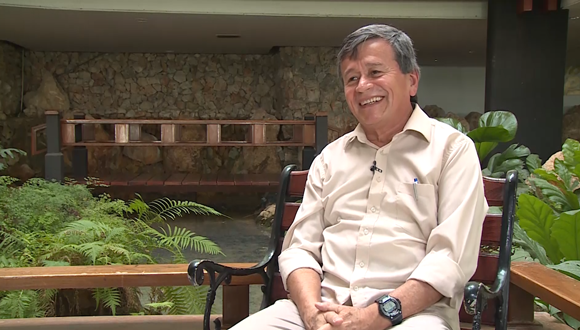
The commander of the National Liberation Army, and negotiator in Havana, Pablo Beltrán.
-Will there ever be peace in Colombia?
-We asked a FARC leader who was killed in this war, Alfonso Cano – with whom the ELN coordinated very well – about this once in a debate, and Alfonso said: ‘Nothing that the people get will be given away, everything has to be fought for. And what is the greatest good? Peace. Will they give it away? It must be fought [for].
“We will never abandon the path of seeking a political solution, but we will always defend ourselves. We have no vocation for martyrdom. One chooses these things because one considers that it is worth living and dying for them; otherwise, one would not choose this path.
In video, interview with Commander Pablo Beltrán
When Violence is Defined with Symbols

When Violence Against Women is Defined with Symbols
 By Ania Terrero
By Ania Terrero
Cubadebate journalist. Graduated in 2018 from the Faculty of Communication of the University of Havana.
On Twitter @AniaTerrero
July 16, 2020
Translated and edited by Walter Lippmann for CubaNews.
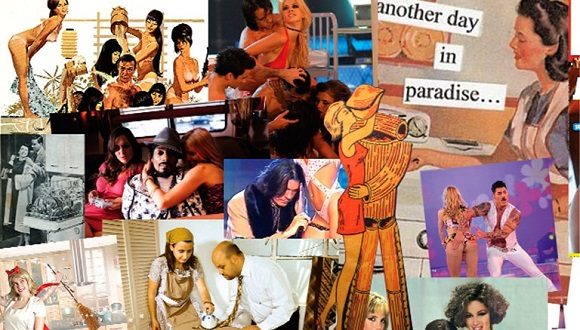
Sexist stereotypes are repeated ad nauseam in the media and cultural industries. Photo: Sophia.
Media that accuse, simplify or ignore victims of gender-based violence; others that silence inequalities. Soap operas that show women concerned about their relationships, motherhood and only later, sometimes for professional fulfillment. Video clips with abundant shots of almost naked dancers, offering their charms to the artist in charge. Advertisements where, while they cook, wash and dream of ideal household appliances, they drive luxury cars and manage life beyond the home.
The list is long: sexist stereotypes are repeated ad nauseam in the media and cultural industries. Over and over again, patriarchal principles are naturalized [socially “acceptable”] according to which women should be beautiful, sensual and delicate, take care of household chores and children, fulfill the sexual desires of their partners and belong to men. They perpetuate, in short, other forms of abuse, although this time in a symbolic way.
In the words of the French theorist Pierre Bourdieu, symbolic violence refers to a group of meanings imposed as valid and legitimate by the patriarchal culture, which are based on male supremacy and domination and, therefore, have a close relationship with power and authority. But the conflict is more complex and has many forms.
As explained by the journalist, professor and expert in gender issues Isabel Moya, in her article From Silence to Media Show, this phenomenon implies “the reproduction in the mass media, and in general, in the cultural industries of a sexist, patriarchal, misogynist discourse that relies on prejudices and stereotypes to present reality and social processes in all areas: the productive and reproductive, the public and the private, the basis of the economic structure and the socio-cultural superstructure”.
In other words, a kind of vicious circle is produced in which the makers of these discourses validate and transmit myths and macho images which, in turn, they inherited from previous generations. By the work and grace of the latent patriarchy, stereotypes persist and are amplified as informative, audiovisual and entertainment alternatives grow.
This happens, moreover, in a world where a relatively small group of transnational companies dominate the information and entertainment market. Conglomerates such as AOL-Time Warner, Disney, Sony, News Corporation, Viacom and Bertelsmann dictate the what and the how. They decide what global audiences will see, hear and enjoy. In short, a few decide for many and influence them.
The greatest danger lies in the fact that, directly or indirectly, they tend to naturalize a gender-biased construction and a subordination scheme where women play at a disadvantage. As a result, it contributes to reproducing the causes of male violence against women and girls.
“The media establish, through their discourses, an axis of cultural matrices, where the hegemonic power is made explicit and reproduced. They constitute one of the mechanisms of reproduction of the patriarchy on the level of subjectivity,” Moya said.
In relation to the above, symbolic male violence must be analyzed in a broader context. As the journalist specializing in gender issues, Lirians Gordillo, explained to Cubadebate, feminism and gender theory had the clarity to demonstrate the interconnection between different forms of discrimination. “The relationship between patriarchy, capitalism and racism, among others, as systems of oppression, allows them to be sustained and updated,” she said.
Therefore, symbolic macho violence is accentuated and acquires particular nuances when other categories such as skin color, place of residence, sexual orientation and gender diversity are involved. It is vital to recognize these forms because they allow us to identify zones of silence where it grows and intensifies.
Abuses that are hidden from view
The first step in dismantling symbolic male violence is to learn to identify it, but this is rarely easy. It often takes more subtle forms than physical, economic, sexual and even psychological. Moreover, it happens in a world of cultures and words where norms are not always clear, where almost everything is considered valid and where, therefore, feminist demands are often assumed to be excesses or exaggerations.
This phenomenon goes beyond perhaps obvious manifestations, such as the objectification of the female body and the re-victimization of those who suffer gender-based violence. Many times, it begins in apparently simple expressions such as silence or absence. The fact that many of the inequities and discriminations that women face today do not usually appear in the media and in entertainment products is a form of abuse.
In the opinion of Lirians Gordillo, because of the fact that what is not named does not exist, removing women with diverse identities from the public stage means not seeing them as people with rights.
“In the Cuban case, we are not talking about women in an abstract concept, but about those who are marked by other features such as skin color, age, gender identity, sexual orientation or the presence of a disability. Perhaps the most absent are transsexual women, lesbian women and black women,” she said.
Addressing gender conflicts from a lack of knowledge, reproducing the stereotypes that make them possible, is as serious, if not more so. According to Isabel Moya, these issues have gone from being “what is not talked about” to being illuminated by the spotlight.
However, she explained, “the lights only illuminate some issues: violence against women, abortion, marriage between homosexuals or lesbians… But more than true light, what prevails, with its honorable exceptions, is the banal approach, the morbidness, the sensationalism that becomes yellowish in some cases. Commonplaces that support myths and stereotypes are repeated ad nauseam”.
And there goes another form of symbolic violence that is almost never evident. Sexism, prejudices and macho representations dominate a good part of the informative and leisure production in the world where we move. They validate a model where women, in more or less obvious ways, are subordinated to men, depend on them or, when they try to make a difference, are excluded. These problems do not only affect them, but also all those who break with the moulds of an essentially conservative society.
Video clips and songs that depict women as objects of desire, films that sell stories where violent men fall in love with nice girls and these girls do their best to save them from themselves, advertising that outlines the roles assigned to each sex and promotes an unattainable ideal of beauty, comedy shows that ridicule homosexual relationships, sensationalist headlines and the stereotypical treatment of gender violence that gains space in the media are just some examples of this phenomenon.
Moya mentions others: “Symbolic violence is exercised when women of the South are treated with folkloristic or xenophobic approaches; when love between women is blamed; when so-called ‘women’s issues’ are confined only to certain sections of newspapers or newsreels; when the lyrics of a song cry out to the four winds to ‘punish’ it; when the protagonist of a series for teenagers only lives for her ‘perfect physique’ and we see her multiplied in dolls, T-shirts and disposable cups”.
The persistence of a sexist language, which privileges the use of the masculine as a universal generic, evidences other forms of macho abuse in the symbolic realm, said Gordillo. This goes beyond written or oral expression and is manifested in other ways in audiovisual products. “We have to analyze what the conflicts of women and men are in series and films, in what roles they appear, and what relationships they establish between themselves,” he added.
Cuba, realities and challenges of a latent violence
Although the work of training and education on gender issues among journalists, communicators, artists and creators has already begun to bear fruit, Cuba does not escape the examples and consequences of symbolic violence.
According to Lirians Gordillo, in audiovisual production, with a few exceptions, a patriarchal representation of women persists. The usual conflicts and interests for them are still the traditional ones: family, couple relationships, aging. Even when they have an active public and professional life, the problems associated with it are subordinated to the previous ones.
As Cuban researchers have pointed out, the public arena is one of the main spaces of progress for Cuban women. “They tend to have greater participation and representation in decision-making in different spheres, but patriarchal relations still prevail within the domestic sphere. It is very curious how this reality is represented in fiction, soap operas and other products,” said the journalist.
At the same time, research on the Cuban press has detected challenges and obstacles that still limit the treatment of issues related to macho violence, human trafficking, feminist struggles, inclusive language and good ways of doing gender journalism.
The last ten years have made some differences if we are talking about symbolic violence. For Gordillo, if one analyzes the informative and entertainment production in that period, one finds more professionals within the communication interested in breaking with macho stereotypes and more communicative products that assume diversity.
This shows the possibilities of a real change and its consequences. However, he said, the majority of products continue to reproduce symbolic violence, even, sometimes, with the intention of being inclusive and not reproducing stereotypes.
According to the journalist, good intentions are not enough because the way we look, the visual codes, the construction and representation of that reality have been formed and educated from the patriarchy. “We have to unlearn many stereotypes, many representations and many macho codes. That needs knowledge, it takes a process of questioning, of getting out of comfort zones above all,” she said.
In this way, filmmakers, artists and communication professionals must combine personal preparation with the use of advisors and specialists when building works and products that approach these issues. Even in those who do not touch on gender conflicts directly, prior training is necessary because these issues usually cut across any representation of society. Alliances between academia, research, communications and artistic creation are vital.
Diversity and systematization of communication products that address male violence is another key point. “Due to its complexity, this problem cannot be analyzed in a single communicative product, once a year or in a specialized media. It is a conflict that needs to be discussed, represented and deconstructed in a systematic and diverse way,” said Gordillo.
Male violence and its expression in the symbolic realm is an urgent challenge. It limits and threatens women’s lives and their rights, but it also affects the development of the nation. Therefore, the best possible response will be one that combines social, political, legal, educational and health efforts, among others, and is articulated as a comprehensive policy. In short, the country we want to be is also at stake.
I Ask You to Move Forward

Gerardo Hernandez:
In Moments Like This I Ask You to Move Forward
July 12, 2020
Translated and edited by Walter Lippmann for CubaNews.
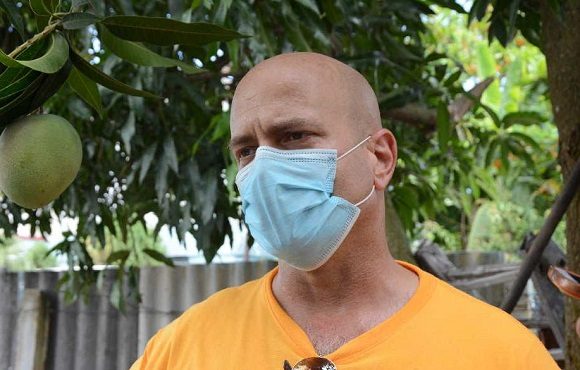
Photo: Vicente Brito/ Escambray.
There is no one like him to know how to assimilate every gesture, every word, every embrace of this or that one from Sancti Spiritus as they pass through the territory, much less to stop to caress a child, admiring a young person or shaking the hand of the one who looks at him as that hero he is. He;s the same one who was condemned to two life sentences, plus 15 years, the same one who confesses not to have words to express his gratitude to those who followed him from a distance and to the Commander in Chief, when 19 years ago, at a crucial moment in the struggle for the liberation of the Five, he said with the certainty of a prophet: ¡Volverán! [They will return!]
“The plan of the empire with me was that I would still be sitting in a maximum-security prison, but if I am here, I owe it to the efforts of so many people who for so many years contributed to the campaign for our freedom, so I thank you, for your contribution to the cause of The Five. This is how Gerardo Hernández Nordelo, the national vice-coordinator of the Committees for the Defense of the Revolution, presented himself to several Sancti Spiritus cederistas during his visit to the province a few days ago.
At present, what new tasks are the CDR facing?
The organization has already issued its bulletin No. 56, dedicated to food production in family yards and plots, because as you know, during the most critical years of the special period in Cuba, progress was made in terms of agro-ecology and ecological practices. We were even recognized by international studies, but after that stage, that popular movement was somewhat lost and today, the idea is to recover it, multiply it and let each one contribute in their own small way.
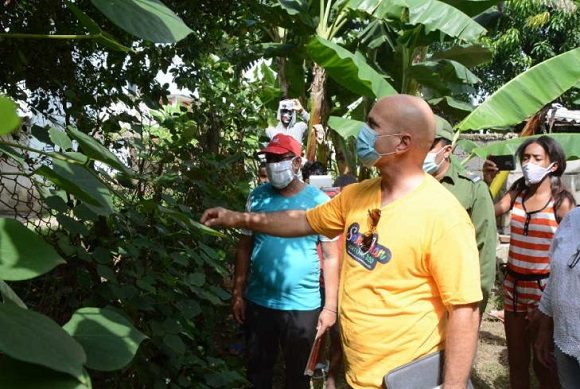
Photo: Vicente Brito/ Escambray.
We have visited places where until recently there were rubbish dumps and the neighbors have cleaned them up and turned them into furrows planted with food. That is the role we play, given that the international economic situation has become more complicated due to the pandemic, and at the same time Cuba continues to suffer the effects of the US blockade.
They, who claim to be so humanitarian, do not make a parenthesis in our discord, not even at times like these, so that Cuba can buy its food and its medicines. On the contrary, not a day goes by that they do not give us another turn of the screw. This is because, in essence, they want to break us, they want to bring us to our knees because of hunger. That is why we, the CDR, try to do things that can contribute to the country, and one of them is food production.
How do the CDRs expand the scope of their work in the midst of a post-COVID-19 recovery phase?
The damage from the pandemic is not only physical for those who have suffered it. It is also economic, and particularly in the area of food, our country is facing difficulties. Even before the arrival of this disease, President Miguel Díaz-Canel Bermúdez called for import substitution, because too many resources are imported, which we can often obtain domestically.
After the appearance of COVID-19, we insisted on this and we were right, because we need to increase production. It is not a question of competing with Agriculture, which has its plans and we wish it every success, but of contributing from our neighborhoods. The potential is there and we can already see the first fruits of this movement. Any bunch of bananas obtained in the courtyard of a house is a product that should not be bought at the market and, therefore, is there for the people who need it most.

Photo: Vicente Brito/ Escambray.
We are a great human family, as our dear Comandante Fidel said, and particularly a great Cuban family, so we must help each other and who better than we who are in the neighborhood to promote this type of activity?
The 60th anniversary of the creation of the CDR is approaching. How will this celebration unfold?
We are working to commemorate, in the most joyful way possible, the 60th anniversary of the creation of the CDRs. We do not yet know the specifics, nor what the activities will be like, because it depends on the evolution of COVID-19 in the country, but I assure you that we will celebrate it as it deserves to be.
The CDRs have also been present in each of the trenches that have been opened up to combat the pandemic and I think they have done so in the spirit of the celebration of this coming 60th anniversary. Let us remember that this is an organization founded by Fidel, one of his great dreams, and in which he placed all his trust to materialize the fundamental task, which is, without a doubt, the defense of the Revolution.
There are those who say that this is an organization of old men, but I assure you that what has changed is time, because far from being out of fashion, we are up to date. At this time it is important to remember and be faithful to the legacy of our Commander and to the trust he placed in the CDR, since he was always very clear that they constituted a bastion of the Revolution and will continue to be so.
How do you assess the role of the youth in the largest mass organization in the country?
Together with other members of the National Directorate of the CDR, we have visited several provinces of the country and one of the things that calls our attention the most is related to the youth and their presence in the organization, contrary to what many people think, we have a very large youth force.
In the 60th Anniversary detachments we met young people who have been in the front line, in the fight against the pandemic, visiting the most needy people, in the assistance centers, distributing products in quarantine zones; but, above all, showing that they have a great desire to do, to contribute and to demonstrate that there is continuity in this organizationgcguu.
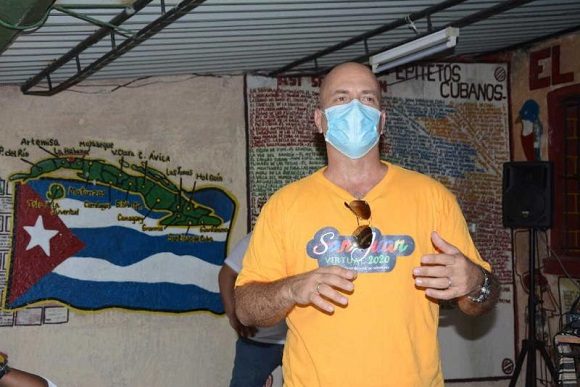
Photo: Vicente Brito/ Escambray.
But there are also the children, who provide the relief of these young people and who are already standing out in the neighborhoods, right now they are the protagonists of the applause of nine o’clock at night, which health workers and all those who in one way or another help in these difficult times quite rightly deserve.
Children, however, are the ones who do most to remind us that it is important to turn off an unnecessary light bulbs at peak times within the home, something that seems insignificant, but if every one of the 138 000 CDRs in the country had a light turned off, that would be the same amount that would stop working to help save energy.
Any message to the people from Sancti Spritus ?
Firstly, to thank you for the solidarity of this people with the struggle of the Five. I share a birthday with Sancti Spíritus and not a single year has passed in which, while in prison, I have not received the congratulations of this people, for which I am very grateful and I do so also in the name of my comrades and our families who have passed through here several times and have always received much affection.
If we are in this province today, we owe it, among other things, to the solidarity of all the people, including that of the people from Sancti Spiritus, therefore, our eternal gratitude, particularly to the CDR members, the FMCers and all those who make up the neighborhood organizations, which we all are.
At times like this I ask you to move forward, or are we going to give in to the pressures of the empire? Of course not, we will continue fighting, saving and producing, fulfilling everything, because better times will come, even if it means working hard.
Ten Tips for Dealing with Confinement

Ten Tips for Dealing with Confinement
 By Frei Betto
By Frei Betto
Carlos Alberto Libânio Christo. Known as Frei Betto. Dominican Friar. Known internationally as a liberation theologian. Author of 60 books in various literary genres – novels, essays, detective stories, memoirs, children’s and young people’s books, and religious books. In two occasions – in 1985 and 2005 – he was awarded the Jabuti, the most important literary prize in the country. In 1986, he was elected Intellectual of the Year by the Brazilian Writers Union. He is an advisor to social movements, to the Basic Ecclesial Communities and to the Landless Rural Workers’ Movement, and has been actively involved in Brazil’s political life for the past 50 years. He is the author of the book “Fidel and Religion”.
Translated and edited by Walter Lippmann for CubaNews.
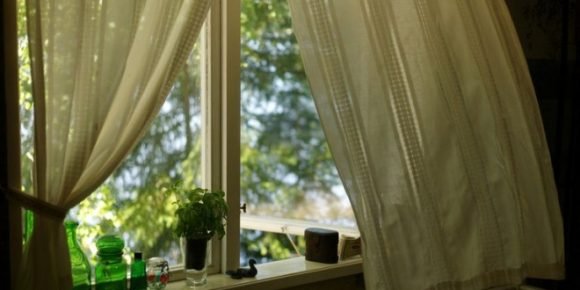
I was detained under the military dictatorship. During my four years in prison, I was locked up in isolation cells in the DOPS[1] in Porto Alegre and the capital of São Paulo, and also in the state of São Paulo, at the headquarters of the PM, at the ROTA Battalion[2], at the State Penitentiary, both in Carandirú and in Presidente Venceslau.
Therefore, I share ten pieces of advice to be able to better endure this period of forced confinement due to the pandemic:
1. Keep body and mind together. Keeping your body confined to your home and your mind focused there, outside can cause depression.
2. Create a routine. Don’t stay in your pajamas all day, as if you were sick. Set a schedule of activities: Physical exercise, especially aerobics (to stimulate the respiratory system), reading, rearranging cupboards, cleaning the house, cooking, researching on the internet, etc.
3. Don’t stay on the TV or computer all day. Diversify your occupations. Don’t ban the passenger who stays all day at the station without having the slightest idea of the train schedule.
4. Use the phone to call relatives and friends, especially the elderly, the vulnerable and those who live alone. Entertain them, it will be good for them and for you.
5. Engage in manual labor: repair appliances, put together puzzles, sew, cook, etc.
6. Play games. If you are in the company of others, set a time of day to play chess, checkers, cards, etc.
7. Keep a quarantine diary. Even if it is without any intention of others reading, do it for yourself. Putting ideas and feelings on paper or on the computer is deeply therapeutic.
8. If there are children or other adults in the house, share household chores with them. Establish a schedule of activities, with common times and free time for each.
9. Meditate. Even if you are not religious, learn to meditate, because it cleanses the mind, retains the imagination, prevents anxiety and relieves tension. Spend at least 30 minutes a day in meditation.
Don’t be convinced that the pandemic will stop quickly or last for months. Act as if the period of confinement will last a long time. In prison, there is nothing worse than the lawyer guaranteeing the client that he will be released in two or three months. That triggers an exhausting expectation. So, prepare yourself for a long journey into your own home.
Frei Betto is a writer, author of “Cartas da prisão” (Letters from the Prison), among other books.
Notes:
1] Department of Political and Social Order (DOPS), a police body which, among other functions, had the police intelligence service. It acted during the dictatorship also with illegal arrests, repression, torture and extermination of people.
2] Tobias de Aguiar Ostensive Rounds (ROTA) is an elite and shock troop of the General Command of the Military Police (PM) of the State of São Paulo. During the dictatorship, he formed the Death Squads
www.freibetto.org/> twitter:@freibetto.
The Wasp Network Stings in Miami

The Wasp Network Stings in Miami
 By Rosa Miriam Elizalde
By Rosa Miriam Elizalde
Cuban journalist. First Vice President of UPEC and Vice President of FELAP. She has a PhD in Communication Sciences and is the author or co-author of the books “Antes de que se me Olvidar”, “Jineteros en La Habana”, “Clic Internet” and “Chávez Nuestro”, among others. She has received the “Juan Gualberto Gómez” National Journalism Award on several occasions. Founder of Cubadebate and its Editor-in-Chief until January 2017. She is a columnist for La Jornada in Mexico.
On twitter: @elizalderosa
July 9, 2020
Translated and edited by Walter Lippmann for CubaNews.
 Since Netflix decided to release The Wasp Network on June 19 and reached the captive audience through Covid, the film has become a media success for unconventional reasons.
Since Netflix decided to release The Wasp Network on June 19 and reached the captive audience through Covid, the film has become a media success for unconventional reasons.
In Florida, they have threatened to burn down movie theaters if the film is ever shown, and signatures are being collected to force Netflix to withdraw the film, not understanding that the download site is not a television channel. People have the option of watching it or going on, although the scandal must have boosted the rating of a film that had passed through the Venice Film Festival without any sorrow or glory, despite a celebrity cast headed by Penélope Cruz.
But in Miami right now the theme of the film has become a sort of anti-communist conga with the local media dancing the cool step of attacking the French director, Olivier Assayas. They’re accusing him of making pro-Cuba propaganda. The great detail is that The Wasp Network narrates real events that have been documented by the United States authorities themselves, in a trial that is considered the longest in the history of that country’s jurisprudence and in which three generals, an admiral, a former presidential advisor and self-confessed terrorists, who appear on screen as what they are, testified.
The plot of The Wasp Network began in Havana in the early 1990s. René González (Edgar Ramírez in the film), a flight instructor at a military airbase, steals a plane and flees Cuba. He begins a new life in Miami, away from Olguita, his wife (played by Penelope Cruz) and their young daughter. Other Cuban “deserters” soon follow him and set up a network to infiltrate organizations based in that city, responsible for attacks on the island, including a hotel bombing campaign that killed an Italian tourist. Instead of capturing and prosecuting the terrorists, responsible for atrocious crimes, the U.S. government locks up and subjects Cuban agents to blackmail and punishment.
It’s the story of what happened in its pure state, naked in the opinions or interpretations of the screenwriter and director; an intolerable truth for one of the real characters in the film, José Basulto. He presented himself in those years as a good Samaritan, savior of rafters in the Florida Straits, but he supported his excursions with drug trafficking, cheerfully violated Cuban airspace and financed shootings against bathers on the beaches.
Paradoxically, the evidence of his crimes was not provided by the Cuban Ministry of the Interior, but by the FBI, which was aware of everything that was going on, as the film shows. Now Basulto shouted against Netflix and shook his fist in front of the cameras: “I more than agree with Trump that the relationship and agreements with Cuba should be terminated.
There’s a story that seems merely anecdotal of events that occurred over 20 years ago, but it’s current if you look at it correctly. Genuine people like José Basulto or Luis Posada Carriles, who organized the bombing of hotels in Havana and the sabotage of a civil airplane in which 73 passengers and crew members died, are not marginal in American society today.
The Cuban from the island who saw The Wasp Network at the Havana Film Festival last December knows that the hatred that inspired the Mayan attacks in the 1990s permeates today the speeches of President Donald Trump and conquers other radicals who swarm the Facebook forums and YouTube channels linked to white supremacists. Moreover, George W. Bush unleashed his war on terrorism from others while protecting his terrorist friends at home, and now Trump courts Florida’s arsonists and is evasive in condemning the right-wing extremists who have left a trail of death during his administration from Charlottesville to Minneapolis to El Paso.
A study by the U.S. Extremist Crime Database indicates that 74% of the terrorist attacks that occurred on U.S. soil after September 11, 2001, through 2016, were the work of the extreme right. Since Trump became president in 2017, most attacks against defenseless civilians have been carried out by supremacists. The profile of the aggressor does not vary much: a white man, inspired by other violent acts and speeches, and with easy access to assault weapons. He is the archetype of José Basulto, who benefited as the current right-wing extremists from the American law, which only allows the designation of foreign groups or attackers as terrorists.
Virtues and shortcomings of performance apart, The Wasp Network is unusual and courageous. It focuses on explaining what was hidden for decades and still does not want to be looked at head-on: why Cuban agents were sent to the United States. This is the heart of the story that has set the networks on fire, that tries to censor on Netflix and that has the right-wing making common cause against the Spanish vice president, Pablo Iglesias. He accompanied the film’s Twitter feed with three words of unsurpassed precision: “Seen it. Heroes. Great Movie.”
Trump takes his politics to Tulsa

Trump went with his politics to Tulsa, scene of the worst massacre of African Americans in recent U.S. history.
By Natalia Plazas
June 20, 2020
Translated and edited by Walter Lippmann for CubaNews.
In 1921 Tulsa, the city Donald Trump chose to resume his campaign for the presidency, was the scene of one of the most atrocious massacres in U.S. history against the Black community. Nearly a hundred years after the event, the facts remain virtually unknown to society.
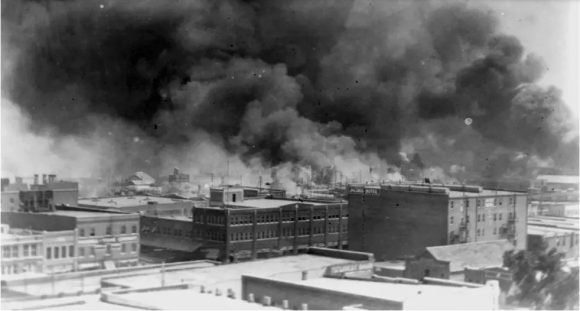
Smoke rises from buildings during the 1921 Tulsa, Oklahoma, USA massacre. Photo: Reuters
Donald Trump hit the nail on the head when he decided to resume his campaign for reelection in Tulsa, Oklahoma. Tens of thousands of his supporters await him there, but there is also a growing call for remembrance and justice from activist groups who remember that that city has not healed the wounds of the worst massacre in the country’s recent history against the African-American community.
On the night of May 31 to June 1, 1921, an entire neighborhood was razed to the ground and 300 black citizens were killed. The massacre began when a white crowd came to lynch a black man accused of sexually assaulting a white woman. That, supposedly, was the trigger for the tragedy, but history has revealed a much more perverse situation.
In the 1920s, the Greenwood neighborhood, a black enclave in the city of Tulsa, was noted for its economic prosperity. The distribution of land after the end of the American Civil War had benefited some African-American and Native American communities, and as a result Greenwood had become stronger, despite being segregated, like any black neighborhood at the time.
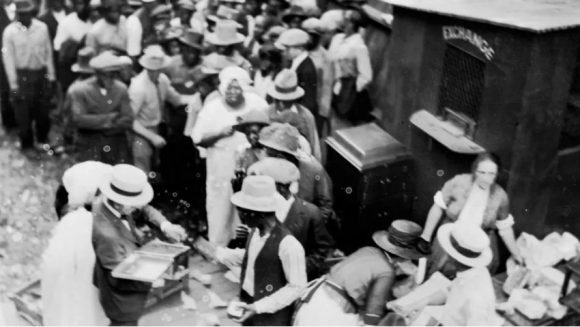
Archive image. A crowd of mostly African Americans lines up at the Exchange booth in Tulsa, Oklahoma, in 1921. © Reuters
From ‘Black Wall Street’ to a neighborhood in the ashes
Such was the commercial and economic success forged in Greenwood that it was commonly called the ‘Black Wall Street’, but soon its good fortune would bring it ruin. Members of the white community began to view their neighbors’ bonanza with suspicion and, interested in occupying their land during the railroad expansion, decided to attack the neighborhood.
On the night of May 31, a crowd of white men, supported by local authorities and even police, arrived in Greenwood and charged at the African-American population and their homes. The mob burned down homes and businesses to the point that when the situation calmed down hours later, at least 35 whole blocks had been left in rubble.
The blow took away the good fortune of the neighborhood forever. In the wake of the event, Greenwood’s recovery has been frustrated by the creation of laws promoting zoning or by building restrictions. Today in Tulsa, the social gap between blacks and whites is notorious. According to a Human Rights Watch report, poverty is almost three times higher among black citizens than among white citizens.
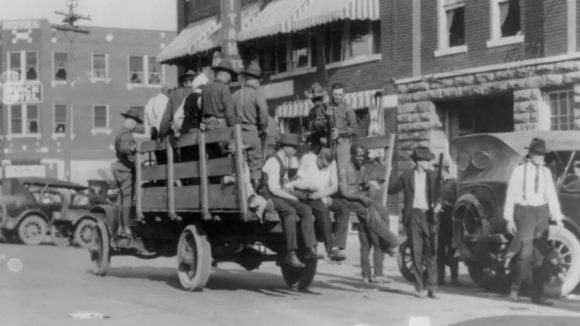
Archive image. A truck carrying soldiers and African Americans near the Litan Hotel during the 1921 Tulsa, Oklahoma race massacre. © Reuters
A Donald Trump rally ignites misgivings in a remote society
With Trump’s visit, originally scheduled to coincide with the celebration of Black Independence Day on June 19 [Juneteenth] and postponed amidst national protests against racism, the call for historical recognition of the victims and economic reparations for their descendants has intensified more than ever.
Less than a year before the 100th anniversary of the Tulsa incident, justice has yet to be established, despite the fact that the case has even been brought before the U.S. Supreme Court. Both lower courts and the high court have dismissed the claims. Currently, only two survivors of the massacre are still alive.
But Trump’s arrival has not only put the spotlight on a forgotten chapter of American history. His desperate attempt to revive in Oklahoma an image that has deteriorated in recent months due to the economic impact of the pandemic has highlighted the differences between his supporters and those who demand changes in the treatment of the African-American community.
“Any protester, anarchist, agitator, looter, or small-time person who goes to Oklahoma, please understand that they will not be treated as they have been in New York, Seattle, or Minneapolis. It will be a very different scene,” the president said before embarking on the trip to Tulsa.
The comment, which his critics call conflictive and divisive, comes at a time when the rejection of racial violence in the United States shows its greatest increase in decades, with weeks of massive demonstrations in multiple cities around the country that have also reached the doors of the White House.
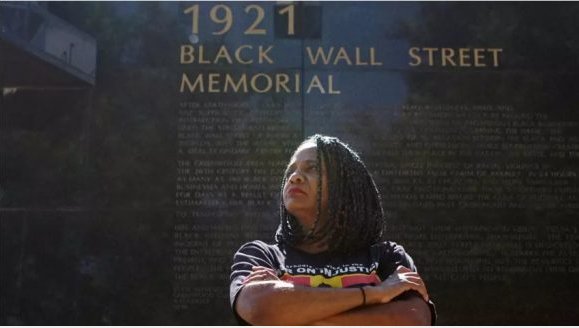
Tulsa Councilwoman Vanessa Hall-Harper poses for a portrait in front of a memorial to the 1921 Greenwood massacre. Tulsa, Oklahoma, USA, June 18, 2020. Lawrence Bryant / Reuters
Death of Two Black Men Hanging from Trees.

Death of Two Black Men Hanging from Trees Sparks Outrage and Raises Questions in the U.S.
By Patricia Sulbarán Lovera
June 16, 2020
Translated and edited by Walter Lippmann for CubaNews.

Robert Fuller and Malcolm Harsch, were found hanging from trees in two southern California cities. Photo: @AAPolicyForum/Twitter.
In the midst of a wave of protests against racism in the United States, two deaths initially labeled as suicides have caused shock and raised questions.
In the last few weeks, the bodies of two black men, Robert Fuller and Malcolm Harsch, were found hanging from trees in two Southern California cities.
In the first announcements, the authorities pointed to suicide as a possible cause of death in both cases, but have now opened investigations.
This was after the families demanded investigations after expressing their unconvinced opinion that they had been suicides.
About 50 miles and 10 days separate the deaths of Fuller and Harsch.
The names of Fuller and Harsch resonated widely on social networks over the weekend, and activists in the Black Lives Matter movement joined the demands of their families.
The characteristics of the incidents have also brought to mind the terrible past of lynching of blacks in the United States in the late 19th and 20th centuries.
Robert Fuller, 24 years old
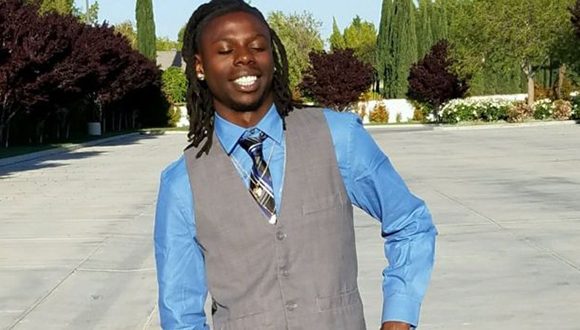
Robert Fuller was 24 years old. Photo: Via GoFundMe.
At almost 4 a.m. last Wednesday, June 10, the body of 24-year-old Fuller was found near City Hall in Palmdale, a city of 150,000 people, about an hour north of Los Angeles.
“No one was at the scene and paramedics found the body hanging from a tree,” Los Angeles County Fire Department Chief Daryl Osby said Monday.
A passerby who saw the body contacted the authorities.
An autopsy was carried out last Friday 12th, the results of which have yet to be announced.
“Initial reports seemed to be consistent with suicide, but we thought it prudent to step back and continue to investigate,” said Jonathan Lucas, head of the county coroner’s office.
Lucas explained that there was initial talk of suicide, due to the “absence of evidence” indicating a possible homicide.
According to authorities, there were no chairs or other artifacts in the vicinity of the site and only “what was in his pocket and backpack” was found, Kent Wegener, in charge of the sheriff’s office homicide unit, said Monday.
Wegener detailed that a forensic analysis of the rope will be done, as well as a study of the type of knot to determine how it was made. They will also investigate whether “there is video footage from surveillance cameras or from homes” that has captured what happened, and they will check the young person’s cell phone.
Authorities said they will also investigate the medical history of Fuller, who was assigned to a state social worker, although the reason is unknown.
According to what county sheriff Alex Villanueva said Monday, the attorney general’s office “is going to monitor and review our investigation.
The official also noted that the FBI (Federal Bureau of Investigation) will be involved in the investigation from the civil rights division.
What was the reaction and what did your family say?
Last Friday, after news of his death was made public, Palmdale residents questioned authorities for first reporting it as a suicide.
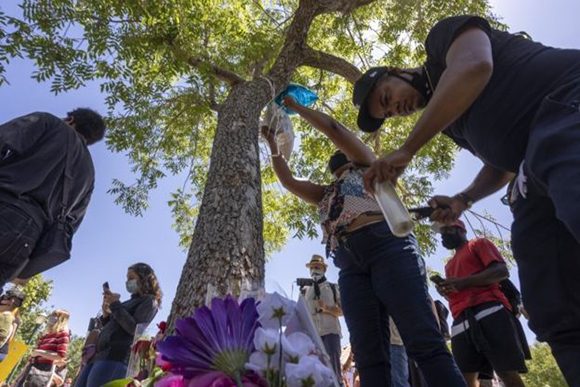
Palmdale residents set up an altar in honor of Fuller on the tree where he was hung on June 10. Photo: Getty Images.
“Where are the surveillance videos?”, “We don’t trust you”, “Why did you conclude it’s a suicide?”, some questioned the city sheriff in the middle of a tense press conference.
On Saturday, Fuller’s sister spoke from the square where the incident occurred and where hundreds of protesters gathered.
“We want to know the truth about what really happened. Robert was a good little brother. And it’s like everything we’ve been told isn’t right (…) we hear one thing and then another, and we just want to know the truth,” Diamond Alexander claimed.
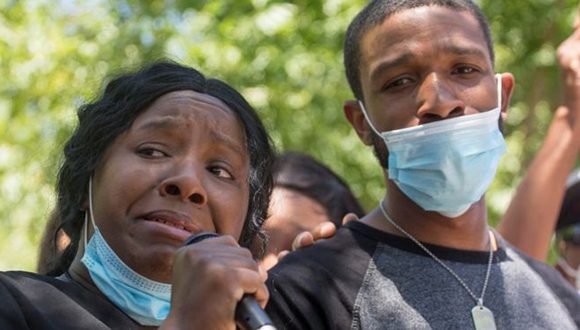
Robert Fuller’s sister said her brother wasn’t suicidal. Photo: Reuters.
“It doesn’t make sense, my brother wasn’t suicidal,” he said.
Antelope Valley, the area where Palmdale is located, “is known in Southern California as a bastion of white supremacy and that goes back decades,” Los Angeles KCRW radio reporter Cerise Castle said in a report Monday for National Public Radio (NPR).
“In 2016, there was an incident in which three men were charged with a hate crime after attacking a group of Latinos in a park. This was one day after the Ku Klux Klan [white supremacist extreme group] held an event in the area,” he said.
Malcolm Harsch, 38
A una hora de Palmdale en dirección este, en la ciudad de Victorville, un grupo de bomberos acudió a la escena en la que Malcolm Harsch, de 38 años, había aparecido colgado de un árbol el pasado 31 de mayo.
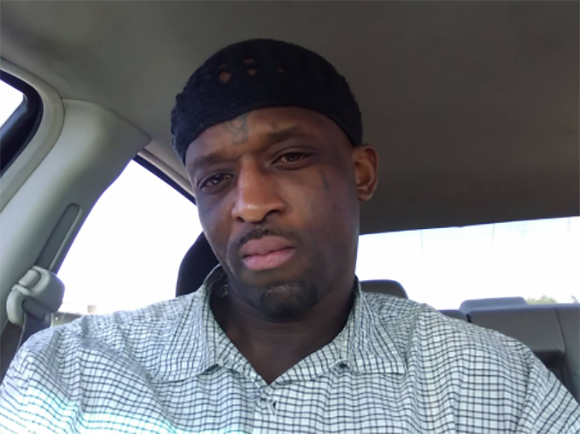
Malcolm Harsch, the 38 años. Photo: @AAPolicyForum/Twitter.
According to the San Bernardino County Sheriff’s Office report, shortly after 7:00 a.m., a call came in to the 911 emergency number from a woman who reported that her boyfriend had hung himself.
The paramedics arrived at the site, which the authorities describe as a “land” where there is a camp of homeless people.
The woman indicated that “she and her boyfriend, later identified as Malcolm Harsch, had been together during the morning, but she had returned to her tent for a short period of time.
“Others in the camp warned him that Harsch had been found hanging from a tree,” that he had been taken down from there and was being given CPR “to resuscitate him,” the statement said.
The emergency personnel who arrived later continued unsuccessfully with the attempts until he was declared dead.
The cause of death is yet to be known.
The authorities present at the scene, including forensic personnel, stated in the letter, “did not collect any evidence suggesting a possible murder”.
What did the family say?
Harsch’s relatives, who live in the state of Ohio, said in a statement last Saturday that they found it hard to believe the man had killed himself, that he “did not seem depressed” and that he had “recently talked with his children about seeing each other soon.
In the letter, the relatives reported that the autopsy had been carried out “12 days after” his death.
“There are many ways to die, but considering the current racial tensions, for a man to have hung himself from a tree definitely does not make sense at this time. We want justice, not easy excuses,” they said.
The city authorities reported that they would make the results of the investigation public once it is completed.
County Sheriff John McMahon said his office was in contact with the state Department of Justice, which was following up on the inquiry.
Subscribe to Blog via Email
| M | T | W | T | F | S | S |
|---|---|---|---|---|---|---|
| 1 | 2 | 3 | 4 | 5 | 6 | 7 |
| 8 | 9 | 10 | 11 | 12 | 13 | 14 |
| 15 | 16 | 17 | 18 | 19 | 20 | 21 |
| 22 | 23 | 24 | 25 | 26 | 27 | 28 |
| 29 | 30 | 31 | ||||

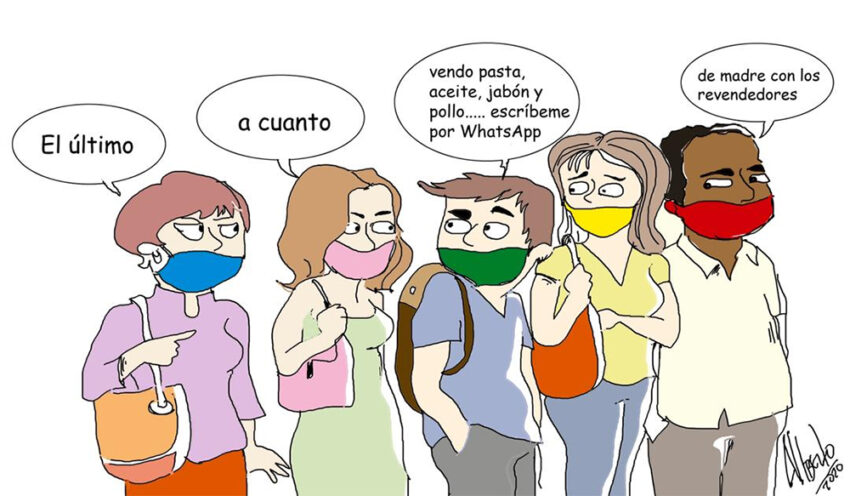

You must be logged in to post a comment.